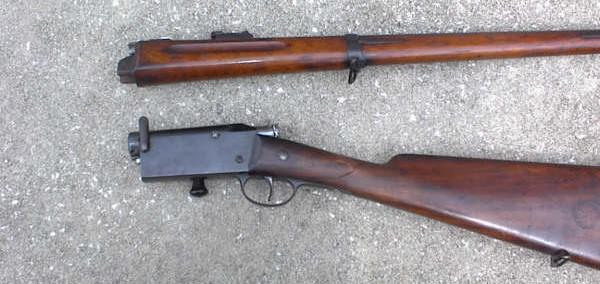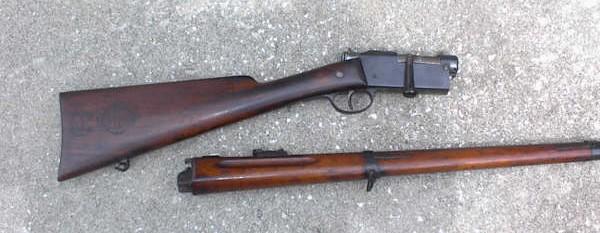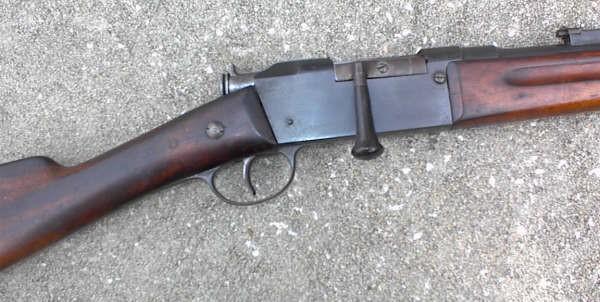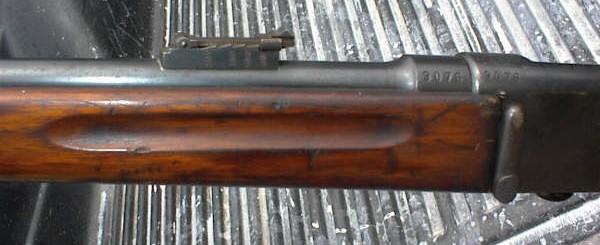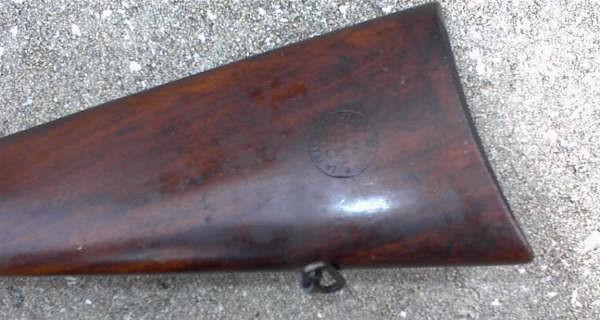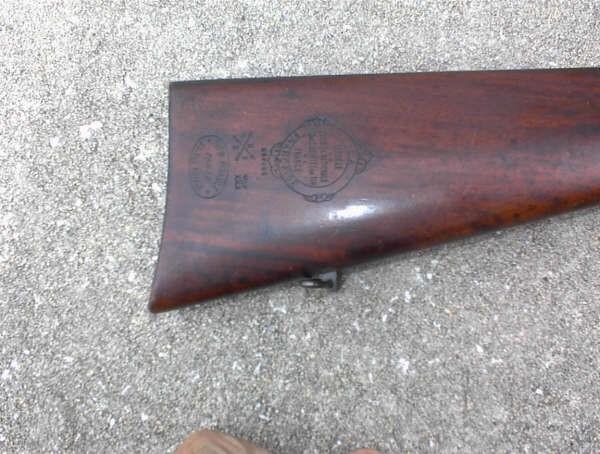Pidault
It’s about one of the very many models of French school rifles, more or less faithful copies of Lebel, which prepared the schoolboys with the “revenge of the defeat of 1870”.
You will find in appendix comparative picture of a school Lebel of an article published in Fire!
Note that if they resemble each other, they are not identical.
That of the site was patented by PIDAULT C. in 1899 (I will apply for the patent…).
The mention “La Francaise C.P. A Longue Portée” refers to the type of cartridge .22 with annular percussion used.
Michel (Belgium)
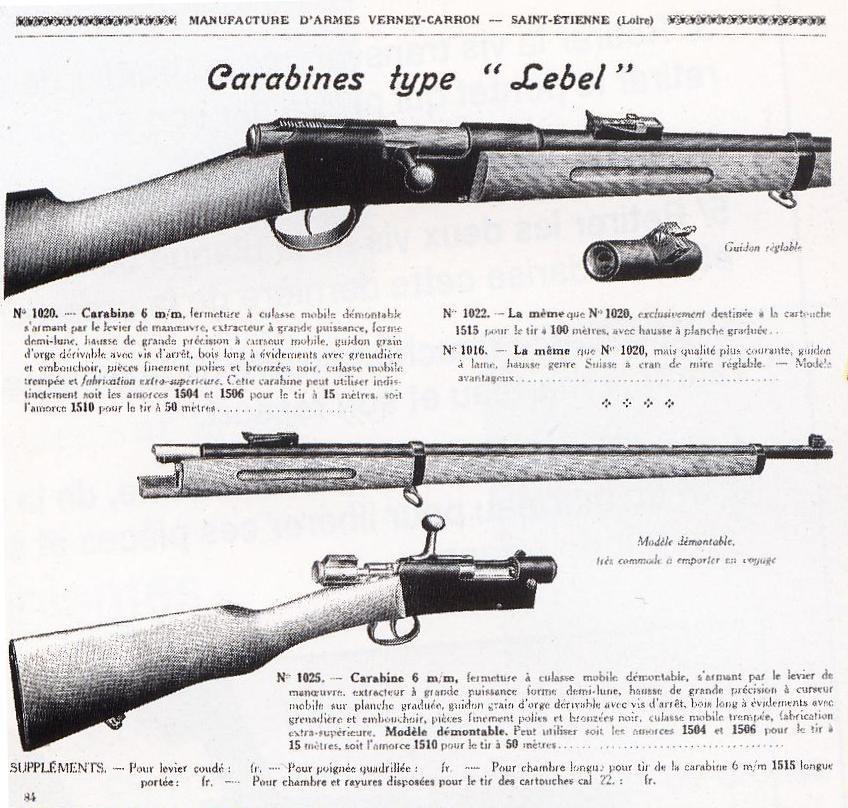
It is about a school rifle of shooting, a very widespread weapon in France at the “Beautiful Time”. Used, at the origin in the French schools for the formation with the shooting of the young children. This model has this of interesting that it is dismountable (Pidault patent). Pidault was a famous Parisian arquebusier who exerted end of the XIXe century at the beginning of XXe.
Cordially,
JP Bastié (France)
At the end of the century spent, the gymnastics or shooting clubs could be equipped with three types of weapons for the shooting at long distance (150-200 meters). Initially Chassepot of the Prussian war, adopted officially in 1866 and of gauge 11 mm, after 1874, Gras rifle, of 11 mm also, and finally rifle 1886 modified 1893 of gauge 8mm, said “Lebel” of the name of its inventor. This excellent weapon, from a reasonable weight (4,180 kg), with which the gunners obtained brilliances results, could draw to a dozen from shots per minute, which represented a considerable progress compared to the three or four shots of the Gras.
For the pupils, a rifle “La Française” was proposed by the Union of the shooting clubs of France, creates in 1886, whose role was to organize national and school championships, to establish records and to prepare youth with obtaining the certificate of military efficiency. The weapon, of gauge 6 millimetres, was planned for the shooting with 10-12 meters but on request, the rifle could be prepared for the shooting with long range (150 to 200 meters); in this case it employed a long cartridge. The pupils of the school of Albepierre laid out, them, of a rifle GRAS system, model 1874 reduced, of a gauge also of 6 millimetres.
The weapons of war could be yielded as loan by the ministry for the War or be yielded subject to payment. Albepierre, for example, acquired against payment of a rifle for the shooting with long range in December 1897, thanks to a subscription opened to this end. With its beginning, the mixed company of Murat had three rifles model 1874-85. In 1891, Aurillacoise declared nine Gras rifles, two Chassepots rifles and four revolvers. Marcenat and Murat respectively had four and six Gras rifles.
After 1908, the S.A.G could lay out of rifle 1886 model 93. It was the case in July 1911 for the S.A.G of Albepierre which had Lebel rifles for its annual contest.
The instruction of April 1892 made it possible the mixed companies of shooting to perceive as loan to the maximum ten rifles Gras model 1874-85 or 1885 and ten rifles or snap hooks modèle1874 M 80 and four revolvers. The excavations practiced in the slope with the front of the pit of the pointers built in 1911 by “La Montagnarde” show very clearly that the shooting club of Albepierre did not have or did not have any more into 1911 of Chassepot rifles or GRAS (or not of ammunition for these weapons), because no ball of gauge 11 mm was found in the slope. In the event of mobilization, the rehabilitation of the weapons was to be immediate and without notice, however it is possible that the lent weapons were not returned because in December 1914 the Minister for the War invited the Generals commanders the areas to place weapons and ammunition at the disposal of the shooting clubs.
The requests for cartridges, subject to payment, were to be addressed to the General ordering the army corps. The delivery of ammunition on a purely free basis could be granted without exceeding 30 cartridges per man annually. From 1908, it is allocated each year free 40 cartridges for the military members and the young old people at least of 17 years, and 20 cartridges for the civil ones and the pupils of the school companies old from 15 to 17 years.
With the origin the ball of rifle Lebel (length 30,5 mm; diameter 8,17mm) was composed of a hardened lead core and “a copper nickel zinc alloy” (Maillechort in French) envelope (invention of Sirs Maillot and Chorier): alloy made up with lead 95% and antimony 5%. This alloy was molten and cast in ball moulds then the cores were compressed and checked before being joined together with the envelope. The envelope was made of an alloy with 80% from copper and pure copper or nickel 20%. The ball was very slightly conical and ended in a light flat part of 4 mm which will disappear in 1890 with the profit from a round top. At the speeds reached by these projectiles of many incidents of shooting were noted by tearing of the envelope involving “left its shirt” partial of the ball. These incidents led to the manufacture of massive brass balls since 1898. The excavations carried out with Albepierre indeed reveal the” brittleness “of the first balls of Lebel.
Sylvain Devaud (Swiss)
In 1894, the ministry for the State education charges a commission with opening a contest for the manufacture of a weapon of instruction which can draw the cartridge “6mm bosquette”, 10 models will be proposed of which one by the “Union Nationale des Sociétés de Tir de France” models “la Française”.
This model will be one of the 2 models retained, after modification of the bead to be in conformity with that of the “Lebel”.
In août1894 the “school one” becomes a lawful weapon although not forming part of the armament of the French Army.
More than 80 gunmakers will manufacture weapons of this type in 6 mm and 22 LR.
HPH (Belgium)

